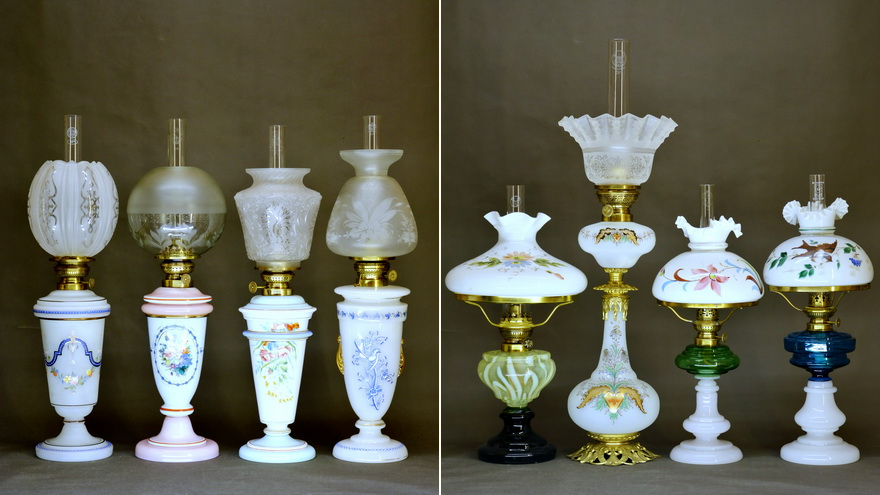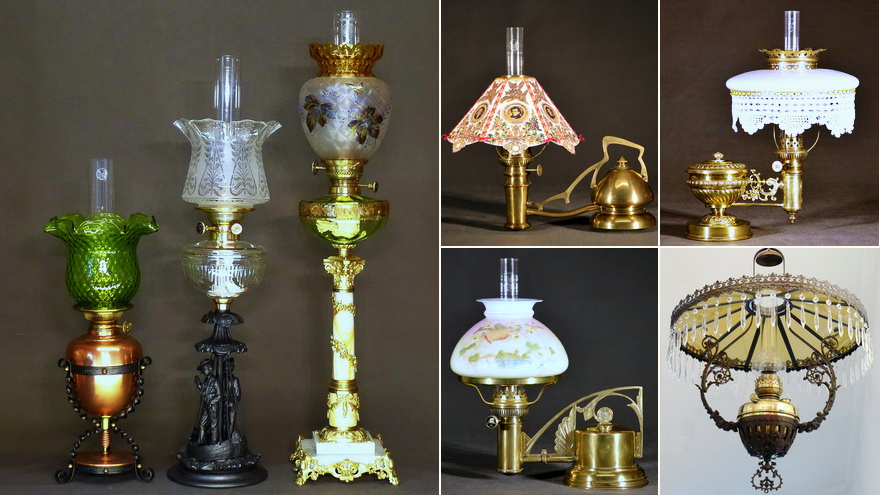Lamps Mainly Made of Glass and Metal
Glass also played an important role in the German lamp industry when it came to producing lamp vases or complete lamps made of glass. In addition to the elaborately painted glass lamps with their inserted, likewise painted glass fonts, there were a very large number of glass lamps whose fonts of differently coloured glass were firmly fused onto the remaining lamp body of white opal glass.
Apart from the dominant zinc casting, other metals played a rather subordinate role. Cast brass was much more expensive to produce than cast zinc, but had the advantage that the lamp parts made with it did not have to be bronzed afterwards. A large number of Art Nouveau lamps were made of brass. A special feature typical of the period were lamps made as a combination of two differently coloured metals. Copper was often combined with brass, but also with black lacquered wrought iron.

Some glass lamps in the collection
From left: L.231 –L.052 – L.208 – L.313 / L.009 – L.074 (Stobwasser) L.053 – L.339
Some glass lamps from German production are elaborately painted similar to porcelain lamps. In particular, finely painted glass lamps were produced during the Classicism period up to about 1875. Three such lamps are shown in the left half of the photo above.
The conical cup-shaped lamp L.231 made of so-called "alabaster glass" is painted with fine floral garlands. The lamp could even be from Wild & Wessel, as the installed Kosmos burner is from W&W. A German tulip shade is used here.
L.052 also has a conical cup shape made of white milk glass painted with a bouquet of flowers at the front. Here, too, the installed burner is from W&W. The beautiful ball shade with engraved floral decoration is likely to be quite old, as this type of decoration is also found on the much older shades for Sinumbra or solar lamps.
L.208 has a very comparable construction to the other lamps in the photo, with the difference that the glass font now sits firmly in the glass vase. Therefore it is not removable. The Kosmos burner is also by W&W, but made for Stübgen in Erfurt. The conically shaped tulip shade is from France.
The fourth, fine glass lamp, L.313, is made of opal glass. The vase is painted with impasto enamel colours in blue and white. Two ornamental golden handles add to the beauty of the lamp. The burner is a very rare, early Kosmos burner by Schwintzer & Gräff with an extinguishing function with a unique spring mechanism.
In contrast, the right half of the photo shows later, simpler, but very typical German glass lamps of the time. L.009 consists of a black glass base and a font of light yellow-green uranium glass. The last two lamps, L.053 and L.339, are also composed of differently coloured base and font parts. All three lamps are fitted with painted Art Nouveau Vesta shades.
The elegant lamp L.074 made of painted glass and with brass mounts is from the oldest Berlin lamp manufacturer Stobwasser. A highly esteemed collector friend has the same lamp complete with the original shade. I have added a French tulip shade to the missing shade. The 20 lines Prometheus burner by Stobwasser completes the lamp.

Brass lamps in the collection
From left: L.092 – L.096 – L.333 (Triumph lamp by Ehrich & Graetz) / L.209 (Kleemann) – L.343 – L.326
The first two lamps are typical metal lamps of German Art Nouveau. I deduce their German origin from the fact that they bear German burners and chimneys. However, their design style and ornamental decorations could also be Austrian. L.092 has a 20 lines Champion burner by Jacob Hirschhorn. L.096 has a 20''' Auto burner by Gebr. Wolff in Neheim; and interestingly, the glass chimney is also marked with a vintage car. This lamp is probably a reverence to the just emerging car industry in Germany.
At first glance, L.333 appears to be a boring, ubiquitous brass lamp, but appearances are deceptive. This lamp is a rare table lamp version of the then quite common Triumph lamps by Ehrich & Graetz, which were mainly used as hanging lamps and therefore also did not have a conventional wick knob, but a special device for regulating the flame height by means of strings hanging downwards. This rare table lamp also has this device, but now you can operate the vertically mounted wick knob by hand. I was able to fit this lamp with a completely preserved 20 lines Triumph burner (incl. the special flame disc that is almost always lost) and the matching Triumph chimney.
Another elegant lamp in pure Art Nouveau style is L.209. This lamp carries a conical glass shade by C.A. Kleemann, embedded in a brass mount. A rare 15’’’ Rex burner by Ehrich & Graetz came with the lamp. The combination of the copper lamp body with the brass mounts gives this lamp a rarely seen appearance.
The L.343 lamp in a distinctly pure Art Nouveau style is quite striking in terms of design. Not only the elegant shaping of the handles, which also carry the shade holder, but also the metal shade made of hammered brass with eye-catching glass inserts make this lamp an Art Nouveau icon. The lamp was equipped with a Reform-Kosmos burner by Bünte & Remmler.
The brass lamp L.326 is no less charming in my eyes, despite its restrained form design, because it marks the transition from Art Nouveau to Art Deco. I have fitted this lamp with a white-light burner from K&T and with a simpler, cut tulip shade, which I think goes well with the lamp.

More German lamps in the collection
From left: L.251 – L.300 and L.075 (both by Stobwasser) / L.111 (Kleemann) / L.148 (Kindermann) / L.162 (K&T) / L.273 (Schubert & Sorge)
In a final photo I put together 7 more German lamps constructed from different materials.
L.251 is a nice example of lamps made of copper and black lacquered wrought iron. This combination was probably a trendy fashion around 1890-1900. Also renowned lamp manufacturers like W&W had lamps with a very similar look in their range. This lamp got a green coloured French tulip shade with matching contrast to the lamp.
The extremely unusual L.300 sculptural lamp from the venerable Berlin lamp manufacturer Stobwasser is intricately assembled from several cast iron parts. Here, two marines stand in a stylised boat, which in turn is placed on a churning sea. This lamp is equipped with a 20’’’ Matador burner by E&G and a British tulip shade.
The extremely elegant L.075 column lamp is also by Stobwasser. This lamp with its very elaborately constructed and also exuberantly decorated base/column combination could probably only be acquired by very wealthy people. A high quality 20 lines Elite burner by Carl Holy and a finely painted glass tulip completed the lamp.
In the right half of the photo, I have shown three German piano lamps and a mighty, overhanging hanging lamp with fan-shaped shade in individual photos. I describe these lamp types in the chapter Other Household Lamps.
The piano lamp L.111 by Kleemann has the typical cardboard shade with composer portraits. These shades were very favoured at the time because they were very light and also very cheap. However, they have not survived the test of time. I made the shade myself from the templates of a collector friend.
The next piano lamp L.148 is by C.F. Kindermann. Again, the shade is my own construction. It consists of a flat glass shade with a crown of openwork brass sheet and a crocheted border. This gives this lamp a unique character.
The piano lamp L.162 in the bottom row is by Kästner & Töbelmann. This lamp in a striking Art Nouveau design has been given a painted Vesta shade by me from the USA.
The last lamp in the picture, L.273, is a large hanging lamp by Schubert & Sorge from the late 19th century. The lamp has a mighty fan-shaped shade made of 10 glass plates and a 30''' Blitz burner by Fr. Hoffmann.


